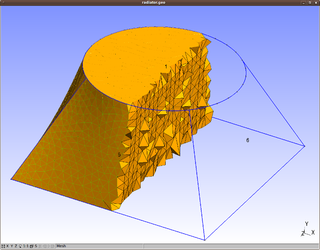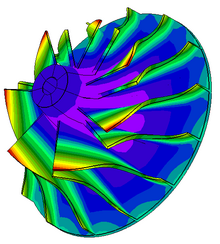
Portage is a package management system originally created for and used by Gentoo Linux and also by ChromeOS, Calculate, Sabayon, and Funtoo Linux among others. Portage is based on the concept of ports collections. Gentoo is sometimes referred to as a meta-distribution due to the extreme flexibility of Portage, which makes it operating-system-independent. The Gentoo/Alt project was concerned with using Portage to manage other operating systems, such as BSDs, macOS and Solaris. The most notable of these implementations is the Gentoo/FreeBSD project.

The FOX toolkit is an open-source, cross-platform widget toolkit, i.e. a library of basic elements for building a graphical user interface (GUI). FOX stands for Free Objects for X.

Open Cascade Technology (OCCT), formerly called CAS.CADE, is an open-source software development platform for 3D CAD, CAM, CAE, etc. that is developed and supported by Open Cascade SAS company.
In computing, the AMIga Window Manager (amiwm) is a stacking window manager for the X Window System written by Marcus Comstedt.
Femap is an engineering analysis program sold by Siemens Digital Industries Software that is used to build finite element models of complex engineering problems ("pre-processing") and view solution results ("post-processing"). It runs on Microsoft Windows and provides CAD import, modeling and meshing tools to create a finite element model, as well as postprocessing functionality that allows mechanical engineers to interpret analysis results. The finite element method allows engineers to virtually model components, assemblies, or systems to determine behavior under a given set of boundary conditions, and is typically used in the design process to reduce costly prototyping and testing, evaluate differing designs and materials, and for structural optimization to reduce weight.

Abaqus FEA is a software suite for finite element analysis and computer-aided engineering, originally released in 1978. The name and logo of this software are based on the abacus calculation tool. The Abaqus product suite consists of five core software products:
- Abaqus/CAE, or "Complete Abaqus Environment". It is a software application used for both the modeling and analysis of mechanical components and assemblies (pre-processing) and visualizing the finite element analysis result. A subset of Abaqus/CAE including only the post-processing module can be launched independently in the Abaqus/Viewer product.
- Abaqus/Standard, a general-purpose Finite-Element analyzer that employs implicit integration scheme (traditional).
- Abaqus/Explicit, a special-purpose Finite-Element analyzer that employs explicit integration scheme to solve highly nonlinear systems with many complex contacts under transient loads.
- Abaqus/CFD, a Computational Fluid Dynamics software application which provides advanced computational fluid dynamics capabilities with extensive support for preprocessing and postprocessing provided in Abaqus/CAE - discontinued in Abaqus 2017 and further releases.
- Abaqus/Electromagnetic, a Computational electromagnetics software application which solves advanced computational electromagnetic problems.
Z88 is a software package for the finite element method (FEM) and topology optimization. A team led by Frank Rieg at the University of Bayreuth started development in 1985 and now the software is used by several universities, as well as small and medium-sized enterprises. Z88 is capable of calculating two and three dimensional element types with a linear approach. The software package contains several solvers and two post-processors and is available for Microsoft Windows, Mac OS X and Unix/Linux computers in 32-bit and 64-bit versions. Benchmark tests conducted in 2007 showed a performance on par with commercial software.

FreeCAD is a general-purpose parametric 3D computer-aided design (CAD) modeler and a building information modeling (BIM) software application with finite element method (FEM) support. It is intended for mechanical engineering product design but also expands to a wider range of uses around engineering, such as architecture or electrical engineering. FreeCAD is free and open-source, under the LGPL-2.0-or-later license, and available for Linux, macOS, and Windows operating systems. Users can extend the functionality of the software using the Python programming language.

Synopsys Simpleware ScanIP is a 3D image processing and model generation software program developed by Synopsys Inc. to visualise, analyse, quantify, segment and export 3D image data from magnetic resonance imaging (MRI), computed tomography (CT), microtomography and other modalities for computer-aided design (CAD), finite element analysis (FEA), computational fluid dynamics (CFD), and 3D printing. The software is used in the life sciences, materials science, nondestructive testing, reverse engineering and petrophysics.

Gmsh is a finite-element mesh generator developed by Christophe Geuzaine and Jean-François Remacle. Released under the GNU General Public License, Gmsh is free software.

OpenSCAD is a free software application for creating solid 3D computer-aided design (CAD) objects. It is a script-only based modeller that uses its own description language; the 3D preview can be manipulated interactively, but cannot be interactively modified in 3D. Instead, an OpenSCAD script specifies geometric primitives and defines how they are modified and combined to render a 3D model. As such, the program performs constructive solid geometry (CSG). OpenSCAD is available for Windows, Linux, and macOS.

Frescobaldi is an editor for LilyPond music files. It aims to be powerful, yet lightweight and easy to use. Frescobaldi is free software, freely available under the GNU General Public License. It is designed to run on all major operating systems. It is named after Girolamo Frescobaldi, an Italian composer of keyboard music in the late Renaissance and early Baroque period.

NX, formerly known as "unigraphics", is an advanced high-end CAD/CAM/CAE, which has been owned since 2007 by Siemens Digital Industries Software. In 2000, Unigraphics purchased SDRC I-DEAS and began an effort to integrate aspects of both software packages into a single product which became Unigraphics NX or NX.
MEDINA is a universal pre-/postprocessor for finite element analysis. The development of MEDINA started in the early 1990s at Daimler-Benz AG and was proceeded at debis Systemhaus. Since 2001 the support and the development of MEDINA takes place by T-Systems International GmbH. The current release is MEDINA Rel. 9.0.1.2
Ansible is a suite of software tools that enables infrastructure as code. It is open-source and the suite includes software provisioning, configuration management, and application deployment functionality.
deal.II is a free, open-source library to solve partial differential equations using the finite element method. The current release is version 9.5, released in July 2023. It is one of the most widely used finite element libraries and provides comprehensive support for all aspects of the solution of partial differential equations. The founding authors of the project — Wolfgang Bangerth, Ralf Hartmann, and Guido Kanschat — won the 2007 J. H. Wilkinson Prize for Numerical Software for deal.II. However, it is a worldwide project with around a dozen "Principal Developers", but over the years several hundred people have contributed substantial pieces of code or documentation to the project.
ACTRAN is a finite element-based computer aided engineering software modeling the acoustic behavior of mechanical systems and parts. Actran is being developed by Free Field Technologies, a Belgian software company founded in 1998 by Jean-Pierre Coyette and Jean-Louis Migeot. Free Field Technologies is a wholly owned subsidiary of the MSC Software Corporation since 2011. Free Field Technologies and MSC Software are part of Hexagon AB since 2017.

Windows Subsystem for Linux (WSL) is a feature of Windows that allows developers to run a Linux environment without the need for a separate virtual machine or dual booting. There are two versions of WSL: WSL 1 and WSL 2. WSL 1 was first released on August 2, 2016, and acts as a compatibility layer for running Linux binary executables by implementing Linux system calls on the Windows kernel. It is available on Windows 10, Windows 10 LTSB/LTSC, Windows 11, Windows Server 2016, Windows Server 2019 and Windows Server 2022.








